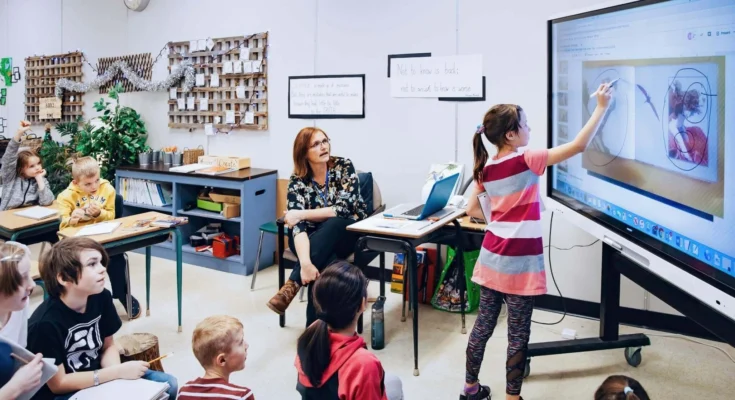The world of education is evolving rapidly. As we step into 2025, the traditional classroom is no longer the only space where learning happens. Thanks to digital classroom solutions, education has become more accessible, engaging, and personalized than ever before. But what exactly do we mean by “digital classroom,” and why is it such a hot topic in 2025?
This article explores the most innovative digital classroom technologies, platforms, tools, and trends shaping education in 2025. Whether you’re an educator, student, parent, or administrator, you’ll discover how these cutting-edge solutions can transform teaching and learning for the better.
What Is a Digital Classroom?
A digital classroom refers to a learning environment that uses technology and online tools to deliver educational content, interact with students, and manage coursework. Unlike traditional classrooms that rely on chalkboards and textbooks, digital classrooms leverage:
- Interactive whiteboards
- Learning Management Systems (LMS)
- Cloud-based collaboration tools
- Video conferencing software
- AI-powered learning platforms
The goal is to create a flexible, engaging, and inclusive educational space that supports both in-person and remote learning.
Why Digital Classrooms Matter in 2025
In 2025, digital transformation in education is not a luxury—it’s a necessity. With the rise of blended learning, remote classrooms, and virtual education platforms, schools are adopting technology not just to survive, but to thrive.
Here’s why digital classroom solutions are more important than ever:
- Flexible Learning: Students can learn anytime, anywhere.
- Inclusive Access: Technology bridges the gap for students with disabilities or those in remote areas.
- Real-Time Feedback: Teachers can assess student progress instantly.
- Cost-Effective: Reduces the need for printed materials and in-person infrastructure.
- Student Engagement: Gamified lessons and multimedia content keep learners interested.
Top Digital Classroom Solutions in 2025
Let’s explore the best digital classroom solutions in 2025, categorized by functionality and use case.
1. Learning Management Systems (LMS)
A robust LMS is the heart of any digital classroom. In 2025, popular LMS platforms include:
- Google Classroom
- Canvas
- Moodle
- Schoology
- Blackboard Learn
These platforms allow teachers to manage assignments, communicate with students, track progress, and integrate third-party tools seamlessly.
Key Features:
- Assignment distribution and grading
- Discussion boards and announcements
- Video integration
- Calendar and scheduling
- Student performance analytics
2. Video Conferencing Tools for Online Classes
With hybrid and remote learning becoming mainstream, real-time video interaction is essential. The top tools include:
- Zoom for Education
- Microsoft Teams
- Google Meet
- Cisco Webex
- BigBlueButton
These platforms offer HD video calls, breakout rooms, screen sharing, whiteboards, and more.
Pro Tip: Look for platforms with low-latency performance and end-to-end encryption to ensure security and smooth communication.
3. AI in Digital Classrooms
In 2025, AI in education is revolutionizing personalized learning. AI tools help automate grading, customize lesson plans, and offer real-time tutoring support.
Popular AI-powered platforms:
- Khan Academy’s AI Tutor
- Socratic by Google
- Century Tech
- Quizlet Learn
- ScribeSense
Benefits:
- Adaptive learning paths
- Smart assessments
- Automated feedback
- Individualized tutoring support
4. Gamified Learning Platforms
Gamification is a huge trend in digital classrooms. It enhances engagement and improves retention. Popular platforms in 2025 include:
- Kahoot!
- Classcraft
- Duolingo for Schools
- Prodigy Math Game
- Minecraft Education Edition
These tools use points, badges, leaderboards, and interactive challenges to make learning fun and effective.
Must-Have Hardware for Digital Classrooms in 2025
Digital education solutions go beyond software. Here’s the essential hardware that supports a modern classroom:
- Interactive Smartboards
- 1:1 student devices (Chromebooks, iPads, laptops)
- High-definition webcams
- Digital writing tablets
- Noise-canceling headphones
Many schools are now investing in AR/VR headsets to provide immersive learning experiences in science, history, and technical training.
Cloud-Based Collaboration Tools
Collaboration is key to learning. These cloud platforms are transforming how students and teachers work together:
- Google Workspace for Education
- Microsoft 365 Education
- Slack for Education
- Trello EDU
- Notion
These platforms allow for real-time document sharing, group projects, task management, and teacher feedback—all in one place.
Top Trends in Digital Classrooms for 2025
1. Hybrid Learning Models
The combination of online and face-to-face education is here to stay. Hybrid models provide flexibility while maintaining personal interaction.
2. AI Tutors and Assistants
More students are now using AI tutors for extra help. These systems use machine learning to analyze progress and offer tailored support.
3. Augmented and Virtual Reality (AR/VR)
AR/VR brings learning to life. From virtual field trips to interactive science labs, students can engage in experiential learning without leaving the classroom.
4. Digital Exams and Proctoring
Online exams with AI proctoring tools like ProctorU and Honorlock ensure academic integrity during assessments, even in remote settings.
5. Blockchain in Education
Blockchain is being used to store and verify educational credentials, assignments, and transcripts securely.
Benefits of Digital Classroom Solutions
The advantages of adopting digital classroom tools in 2025 include:
- Increased engagement and motivation
- Real-time performance tracking
- Improved collaboration
- Greater accessibility
- Eco-friendly and paperless learning
Challenges of Digital Classrooms
Despite all the benefits, digital learning environments also face challenges:
- Internet access inequality
- Digital fatigue and screen time
- Cybersecurity concerns
- Lack of personalized teacher-student interaction
- Tech infrastructure costs
Solving these problems involves investment, proper training, and responsible use of technology.
How Teachers Are Adapting in 2025
Today’s educators need to wear many hats. In 2025, teachers are also content creators, facilitators, and tech support. Professional development in digital pedagogy is now standard across schools.
Skills every teacher needs:
- Mastering digital tools
- Creating engaging online content
- Managing hybrid classrooms
- Using data analytics for student progress
- Communicating with parents digitally
Real-World Examples of Digital Classroom Success
Case Study 1: Finland
Finland, known for its progressive education system, has fully integrated AI tutors and digital whiteboards into all high schools. Teachers report 30% higher engagement and better test results.
Case Study 2: India’s Smart Village Schools
With support from NGOs and the government, rural schools in India have been equipped with solar-powered digital classrooms using tablets and projectors. The impact? A 50% increase in attendance and significant improvement in English and Math skills.
Case Study 3: U.S. Virtual Charter Schools
Thousands of students in the U.S. now attend fully virtual public charter schools that use AI-driven LMS, gamified courses, and cloud collaboration. These schools offer flexible learning for gifted and homeschooled students.
Digital Classroom Tools for Different Education Levels
Elementary (Grades 1–5)
- Tools: ClassDojo, Seesaw, PBS LearningMedia
- Focus: Gamified learning, visual content, parental updates
Middle & High School (Grades 6–12)
- Tools: Edmodo, Google Classroom, Quizlet
- Focus: Collaboration, test prep, interactive lessons
College/University
- Tools: Canvas, Blackboard, Coursera
- Focus: Advanced content delivery, peer discussion forums, asynchronous learning
Tips for Schools Adopting Digital Classrooms
- Start with a strategy – Assess current needs, goals, and available resources.
- Invest in teacher training – Technology is only as effective as the people using it.
- Ensure device access for all students – Consider BYOD or government-supported devices.
- Build strong IT support – Ensure smooth usage, troubleshooting, and security.
- Use student feedback – Continuously improve based on what works and what doesn’t.
The Future of Digital Education
By 2030, it’s likely that AI-powered learning ecosystems, adaptive testing, and global virtual schools will dominate. Education will become even more data-driven, personalized, and student-centric. Students will have personal learning dashboards that update in real time based on their interests, habits, and academic progress.
FAQs
Q1: What are the best digital classroom tools in 2025?
A: Top tools include Google Classroom, Canvas, Zoom, Kahoot!, and AI tutors like Century Tech.
Q2: How can schools ensure security in digital classrooms?
A: Use encrypted platforms, role-based access, and cybersecurity training for staff and students.
Q3: Is digital learning as effective as traditional learning?
A: Studies show that blended learning can be even more effective, especially when personalized and supported by strong digital content.
Q4: Can digital classrooms help special needs students?
A: Absolutely. Assistive technologies, speech-to-text tools, and flexible pacing make digital classrooms more inclusive.
Q5: What’s the biggest trend in education technology for 2025?
A: The rise of AI tutors, VR classrooms, and blockchain-based credentialing systems.
Conclusion: Embracing the Digital Classroom of Tomorrow
As we navigate 2025, digital classroom solutions are more than just tools—they’re gateways to better learning experiences. From AI tutors and gamified platforms to cloud-based collaboration and virtual reality, the classroom of the future is already here.
Educators who adapt to this digital shift will not only enhance student learning but also prepare them for the demands of a tech-driven world. Students will become creative problem solvers, tech-savvy communicators, and lifelong learners.
So whether you’re upgrading your school’s tech, designing your home learning space, or preparing to teach online, one thing’s for sure—digital classrooms in 2025 are smarter, more inclusive, and more powerful than ever before.




